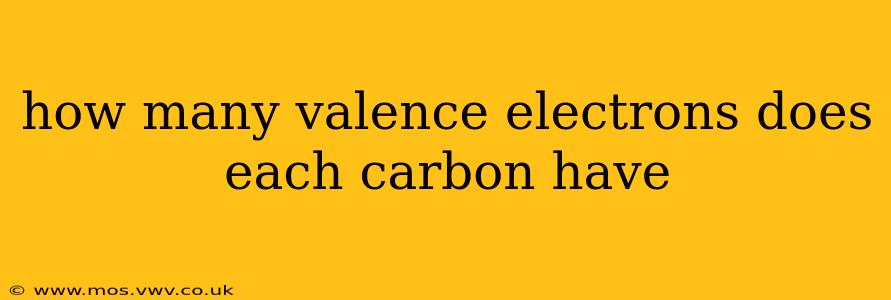How Many Valence Electrons Does Each Carbon Atom Have?
Carbon, the fundamental building block of organic life, boasts a fascinating electronic structure. Understanding its valence electrons is key to grasping its incredible bonding capabilities and the vast diversity of organic molecules. So, how many valence electrons does each carbon atom possess? The answer is four.
Let's delve deeper into why this is the case and explore the implications of this number.
What are Valence Electrons?
Before we answer the central question, let's clarify what valence electrons are. Valence electrons are the electrons located in the outermost shell (or energy level) of an atom. These electrons are the ones involved in chemical bonding, determining an element's reactivity and the types of bonds it can form. They are the key players in determining an element's chemical behavior.
Carbon's Electron Configuration
Carbon's atomic number is 6, meaning it has six protons and six electrons. These electrons are distributed in energy levels (or shells) around the nucleus. The electronic configuration of a carbon atom is 1s²2s²2p².
- 1s²: Two electrons occupy the first energy level (the innermost shell).
- 2s²: Two electrons occupy the second energy level's s subshell.
- 2p²: Two electrons occupy the second energy level's p subshell.
The outermost shell for carbon is the second energy level, which contains a total of four electrons (two from the 2s subshell and two from the 2p subshell). Therefore, carbon has four valence electrons.
Why are Carbon's Four Valence Electrons Important?
The presence of four valence electrons is the reason behind carbon's exceptional ability to form a wide variety of compounds. These four electrons allow carbon to form four covalent bonds – strong bonds where atoms share electrons. This tetravalency is crucial for the formation of long chains, branched structures, and rings, making carbon the backbone of countless organic molecules, from simple hydrocarbons to complex biomolecules like proteins and DNA.
How does Carbon form bonds?
Carbon can form single, double, and triple covalent bonds with other atoms, including other carbon atoms. This versatility allows for the immense diversity seen in organic chemistry. It can form bonds with hydrogen, oxygen, nitrogen, sulfur, and many other elements.
What are some examples of carbon compounds?
The implications of carbon's four valence electrons are immense. Consider the following examples:
- Methane (CH₄): Carbon forms four single bonds with four hydrogen atoms.
- Ethene (C₂H₄): Two carbon atoms form a double bond between them, and each carbon also forms two single bonds with hydrogen atoms.
- Ethyne (C₂H₂): Two carbon atoms form a triple bond between them, and each carbon also forms a single bond with a hydrogen atom.
- Benzene (C₆H₆): Six carbon atoms form a ring structure with alternating single and double bonds.
These examples illustrate just a tiny fraction of the countless possibilities arising from carbon's unique electronic configuration.
In conclusion, the presence of four valence electrons in each carbon atom is the foundation of organic chemistry and the vast diversity of organic molecules crucial to life as we know it. This fundamental aspect of carbon's electronic structure drives its remarkable bonding capabilities and allows for the formation of complex and diverse molecules that shape our world.
